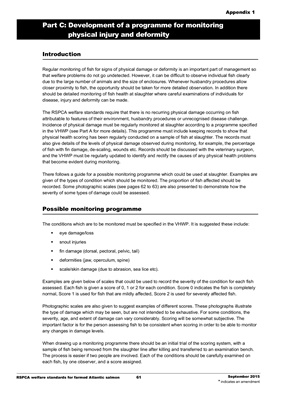
Appendix 1
RSPCA welfare standards for farmed Atlantic salmon 61 September 2015
* indicates an amendment
Part C: Development of a programme for monitoring
physical injury and deformity
Introduction
Regular monitoring of fish for signs of physical damage or deformity is an important part of management so
that welfare problems do not go undetected. However, it can be difficult to observe individual fish clearly
due to the large number of animals and the size of enclosures. Whenever husbandry procedures allow
closer proximity to fish, the opportunity should be taken for more detailed observation. In addition there
should be detailed monitoring of fish health at slaughter where careful examinations of individuals for
disease, injury and deformity can be made.
The RSPCA welfare standards require that there is no recurring physical damage occurring on fish
attributable to features of their environment, husbandry procedures or unrecognised disease challenge.
Incidence of physical damage must be regularly monitored at slaughter according to a programme specified
in the VHWP (see Part A for more details). This programme must include keeping records to show that
physical health scoring has been regularly conducted on a sample of fish at slaughter. The records must
also give details of the levels of physical damage observed during monitoring, for example, the percentage
of fish with fin damage, de-scaling, wounds etc. Records should be discussed with the veterinary surgeon,
and the VHWP must be regularly updated to identify and rectify the causes of any physical health problems
that become evident during monitoring.
There follows a guide for a possible monitoring programme which could be used at slaughter. Examples are
given of the types of condition which should be monitored. The proportion of fish affected should be
recorded. Some photographic scales (see pages 62 to 63) are also presented to demonstrate how the
severity of some types of damage could be assessed.
Possible monitoring programme
The conditions which are to be monitored must be specified in the VHWP. It is suggested these include:
eye damage/loss
snout injuries
fin damage (dorsal, pectoral, pelvic, tail)
deformities (jaw, operculum, spine)
scale/skin damage (due to abrasion, sea lice etc).
Examples are given below of scales that could be used to record the severity of the condition for each fish
assessed. Each fish is given a score of 0, 1 or 2 for each condition. Score 0 indicates the fish is completely
normal, Score 1 is used for fish that are mildly affected, Score 2 is used for severely affected fish.
Photographic scales are also given to suggest examples of different scores. These photographs illustrate
the type of damage which may be seen, but are not intended to be exhaustive. For some conditions, the
severity, age, and extent of damage can vary considerably. Scoring will be somewhat subjective. The
important factor is for the person assessing fish to be consistent when scoring in order to be able to monitor
any changes in damage levels.
When drawing up a monitoring programme there should be an initial trial of the scoring system, with a
sample of fish being removed from the slaughter line after killing and transferred to an examination bench.
The process is easier if two people are involved. Each of the conditions should be carefully examined on
each fish, by one observer, and a score assigned.